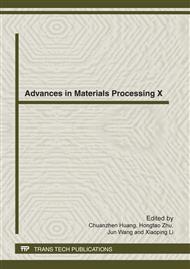p.94
p.99
p.105
p.111
p.117
p.123
p.128
p.134
p.140
Experimental Study on Wear-Resistance of Machined Surface in High Speed Milling Aviation Aluminum Alloy
Abstract:
The wear-resistance performance of machined surface is an important factor in the evaluation of surface quality and precision in aerospace manufacturing industry. By using high-speed Ring-Block friction and wear machine (MRH-3), the influence of cutting parameters in milling aluminum alloy 7050-T7451 on wear-resistance of machined surface including friction coefficient and wear quantity are experimentally investigated. The wear-resistance is particularly sensitive to cutting speed and feed rate. The friction coefficient has marked drop trends as cutting speed increases. The influence of cutting speed on wear quantity is more complicated and the tendency of wear quantity was ascend in first and descend at last (v>900/min). The results show that the influence of cutting parameters on wear-resistance was also positively correlated with surface roughness and work-hardening of machined surface. The high work-hardening and surface quality had the promoting effecting on wear-resistance. The experiment and analysis results show that the machined surface by high speed cutting and lower feed rate has more superior in surface quality and wear-resistance performance comparing with conventional cutting speed.
Info:
Periodical:
Pages:
117-122
Citation:
Online since:
April 2012
Authors:
Price:
Сopyright:
© 2012 Trans Tech Publications Ltd. All Rights Reserved
Share:
Citation:


